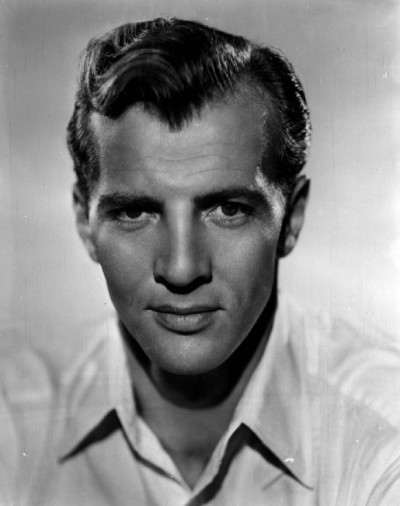Bruce Bennett (Harold Herman Brix)

Harold Herman Brix was the fourth child in a family of five of an immigrant couple from Germany. His eldest brother, and their father’s favored son, Herman, died before Harold’s birth; and he was given his middle name in this child’s memory. To please his father, by high school, he had discontinued using his own first name in favor of his middle name. His father was a lumber man who owned a couple of logging camps. His first career was as an athlete. At the University of Washington, where he majored in Economics, he played football (tackle) in the 1926 Rose Bowl and was a track-and-field star. Two years later, he won the Silver medal for the shot put in the 1928 Olympic Games. He also won four consecutive AAU shot put titles (1928–31), the NCAA title in 1927, and the AAU indoor titles in 1930 and 1932. In 1930 he set a world indoor record at 15.61 m. In 1932 he set his personal best at 16.07 m, but did worse at the Olympic trials and failed to qualify for the Los Angeles Games.
Brix moved to Los Angeles in 1929 after being invited to compete for the Los Angeles Athletic Club and befriended actor Douglas Fairbanks Jr., who arranged a screen test for him at Paramount. In 1931, MGM, adapting author Edgar Rice Burroughs’s popular Tarzan adventures for the screen, selected Herman Brix to play the title character. Unfortunately, Brix broke his shoulder filming the 1931 football film Touchdown. Swimming champion Johnny Weissmuller replaced Brix and became a major star. After Ashton Dearholt convinced Burroughs to allow him to form Burroughs-Tarzan Enterprises, Inc., and make a Tarzan serial film, Dearholt cast Brix in the lead. Pressbook copy has it that Burroughs made the choice himself, but, in fact, in his biography, Brix confirmed that Burroughs never even saw him until after the contract was signed, and then only briefly. The film was begun on location in Guatemala, under rugged conditions (jungle diseases and cash shortages were frequent). Brix did his own stunts, including a fall to rocky cliffs below. The Washington Post quoted Gabe Essoe’s passage from his book Tarzan of the Movies: “Brix’s portrayal was the only time between the silents and the 1960s that Tarzan was accurately depicted in films. He was mannered, cultured, soft-spoken, a well educated English lord who spoke several languages, and didn’t grunt.” Due to financial mismanagement, Dearholt had to complete filming of much of the serial back in Hollywood, and Brix, although his travel and daily living expenses in Guatemala were covered throughout the shoot, never received his contracted salary, along with the rest of the cast. The finished film, The New Adventures of Tarzan, was released in 1935 by Burroughs-Tarzan, and offered to theatres as a 12-chapter serial or a seven-reel feature. A second feature, Tarzan and the Green Goddess, was culled from the footage in 1938. He also portrayed the titular hero in Republic’s serial Hawk of the Wilderness.
Brix continued to work in serials and action features for low-budget studios until 1939. Finding himself still typecast as Tarzan in the minds of major producers, Brix changed his name to “Bruce Bennett” and became a member of Columbia Pictures’ stock company. During the next few years he would be seen playing minor roles in many Columbia films, from expensive dramas to B mysteries to Three Stooges short subjects (including How High Is Up?). His screen career was interrupted by World War II, when he served in the United States Navy. Bennett appeared in many films in the 1940s and early 1950s, including Sahara (1943) with Humphrey Bogart, Mildred Pierce (1945) with Joan Crawford, Nora Prentiss (1947) with Ann Sheridan, Dark Passage (1947) with Bogart and Lauren Bacall, The Treasure of the Sierra Madre (1948) with Bogart and Walter Huston, Mystery Street (1950) with Ricardo Montalban, Sudden Fear (1952) with Joan Crawford and Gloria Grahame and Strategic Air Command (1955) with James Stewart. The Washington Post noted, “Bennett moved into grittier roles in the late 1940s and early 1950s, playing a detective in William Castle’s Undertow and a forensic scientist who helps solve a crime in John Sturges’ Mystery Street. He also portrayed an ageing baseball player in Angels in the Outfield (1951). In 1954, Bennett played William Quantrill, the Confederate guerrilla figure, in an episode of the syndicated television series Stories of the Century, starring and narrated by Jim Davis. Bennett made five guest appearances on Perry Mason including his role as murder victim Lawrence Balfour in the 1958 episode, “The Case of the Lucky Loser,” and murderer Dan Morgan in the 1961 episode, “The Case of the Misguided Missile.”
Bennett had two children, Christopher Brix and Christina Katich, by longtime wife Jeannette, who died in 2000. They named their children after his parents. They had three grandchildren and two great-grandchildren. His great-niece is named Brix Hahn in his honor. From the mid-1950s on, Bennett mainly appeared in B-films, such as The Alligator People (1959), and in the title role of the Fiend of Dope Island (filmed 1959, released 1961) that he co-wrote, and on television in guest starring roles. He was a very successful businessman during the 1960s. A lifelong parasailer and skydiver, he last went skydiving (from an altitude of 10,000 feet) over Lake Tahoe, at the age of 96. Bennett turned 100 on May 19, 2006, and died less than a year later in February 2007 of complications from a broken hip.
Born
- May, 19, 1906
- USA
- Tacoma, Washington
Died
- February, 24, 2007
- USA
- Santa Monica, California
Cause of Death
- complications from broken hip
Other
- Cremated

